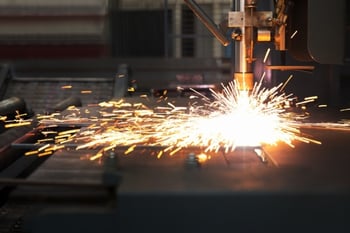 One of the key advantages of using metal over plastic (aside from tensile strength, durability, and useful life) for custom wire baskets is that many metal alloys have a melting point several times higher than most plastics.
One of the key advantages of using metal over plastic (aside from tensile strength, durability, and useful life) for custom wire baskets is that many metal alloys have a melting point several times higher than most plastics.
But, even with metal alloys, performance characteristics such as tensile strength, impact resistance, and corrosion resistance can degrade when the metal has been heated to a high temperature.
Taking into account how high temperatures will affect the performance of a metal alloy is a critical part of making the best material handling and parts washing baskets.
So, how do many popular metal basket materials hold up at 2,000 degrees Fahrenheit (1093°C)?
Plain Steel
So-called plain steel actually covers a variety of alloys, including mild-, low-, and high-carbon steel. The biggest variable in these alloys is the carbon content, which affects tensile strength and tempering.
Plain carbon steel can be heat treated to alter its mechanical properties, such as ductility and yield strength. The highest temperature involved in heat treating steel is typically 1,292°F (700°C).
It’s important to note that as carbon content increases in a plain steel alloy, the alloy’s temperature tolerance tends to decrease. For example, a 0.2% carbon alloy has a burning temperature of 2,680°F (1,471°C) while a 1.5% carbon alloy burns at 2,080°F (1,140°C).
Considering that’s the temperature at which these alloys burn, they’re wholly unsuited to consistent use in environments where temperatures routinely reach 2,000°F.
Stainless Steel
Like plain steel, the term stainless steel can be applied to a wide variety of different alloys. A key characteristic of stainless steel is its protective oxide layer—which continuous exposure to extreme temperatures can damage.
There are hundreds of different alloys, but let’s take a quick look at some of the more commonly-used alloys:
- Grade 304 Stainless Steel. Resistant to oxidation damage at temperatures of up to 1,697°F (952°C). At 2,000°F, this alloy will experience significant loss of corrosion resistance and tensile strength.
- Grade 316 Stainless Steel. While more resistant to chemical corrosion at room temperature than 304 SS, 316 SS is actually a bit less resistant to high temperatures than 304 is. At 2,000°F, this alloy loses even more tensile strength than 304 does.
- Grade 330 Stainless Steel. This stainless steel alloy is specifically formulated to resist the effects of scaling and oxidation at high temperatures. The high chromium and nickel content of this alloy helps it withstand prolonged exposure to temperatures of up to 1,900°F (1037°C). Some might recommend it for use at 2,000°F, but at that point it’s usually better to use Inconel® instead.
Inconel 625®
Inconel® is a specially-formulated family of alloys designed for use in extremely high temperatures.
At a temperature of 2,000°F, Inconel 625® has an ultimate tensile strength of 13.3 KSI (13,300 psi). This is significantly less than its room temperature strength of 138.8 KSI (138,800 psi), but still more than enough to retain its shape and hold most lightweight parts.
To make the best steel wire basket, it’s important to consider not just the type of material to use, but how thick each wire should be, how they should be joined, how parts will be carried/moved, and what stresses the basket will be exposed to.
Designing a basket for such extreme temperatures is a massive challenge. But, with the right know-how and tools, even a 2,000°F process can be overcome.



.gif)


